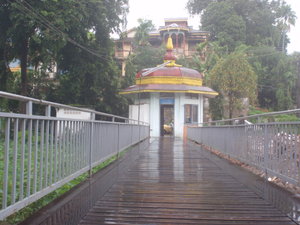Advertisement
Published: September 26th 2010

 Vippasana
Vippasana
Welcome to Paradise This was my first thought as I walked through the front door of the Dhama Joti Vippasana Meditation center. There are hundreds of Vippasana centers all over the world and it all started from right here, in Burma(Myanmar). I attended my first hardcore Vippasana course back a year ago when I was in Nepal, and I barely made it out alive. Now, for some insane reason, I find myself walking into another Vippasana course. The only difference this time is that I’m walking into battle with my pops.
Allow me to paint the picture of what this rigorous course looks like. Keep in mind that in no way am I exaggerating or complaining for if there is one thing that Vippasanna has taught me, it’s to observe reality for what it is. The basic rules entail: no speaking, no eye contact, no hand gestures, no singing, no reading, no writing no humming(?!), no exercise, no music, no technology and no pictures. Basically, a very eventful day of doing absolutely nothing except meditate, eat and sleep. On top of that, we are not to have comfortable beds, only cold showers and we

 Meditation Hall
Meditation Hall
Trapped here dsuring meditation... hahaare only allowed to eat two meals a day (breakfast and lunch). These rules are all strictly enforced by the Dhama helpers who make damn sure you follow them, hehe. These are all necessary rules that we have to follow in order for our minds to be calm enough to reach deep into the subconscious during meditation.
Our meditation sessions are grueling as we have a 17 hour work day for 10 straight days. 17 hours. We start at 4:30 am and end at 9:30 pm. Now, thinking one is able to start meditating at 4:30 in the morning and actually doing it is two completely different things. Most of the time, I’m braindead and can barely muster enough energy to walk myself to the meditation hall without falling asleep. The worst part is that the first meditation session of the day is the longest; 2 straight hours. So it is quite clear now: one has to sit there with eyes closed, barely awake and meditate for 2 consecutive hours without falling asleep. So this is what my mind was like…
“OK, quiet down. Let’s begin meditati….ZZZ… oh Whoa! Wake up ,wake up. Be calm, be calm. Concentrate. Just concen….ZZZ… Whoa! Wake up Vic! Let’s do it aga…. ZZZ…” This was only the first 2 minutes, imagine doing that for 2 hours and you’ll understand my suffering. There were so many times where I almost completely dozed off and fell on the meditator in front of me. So many times… hehe. This experience was so tough that I’m going to start using it as a simile. As in “Wow! That GMAT is as tough as meditating for 2 hours at 4:30 am for 11 straight days!”
So, again, I ask myself
What the hell am I doing back here? The answer is actually quite simple: Nibbana (enlightenment). There’s no other reason I would put myself through this kind of hell unless it was for enlightenment. The Vippasana course sets the individual on the path of Dhamma (the Enlightened One’s teaching) which will eventually guide them to nibbana if they practice hard enough. No amount of rites, praying, rituals, chanting and good deeds will help the individual reach enlightenment. It must be done through meditating in the proper way and following Buddha’s original teachings is the right way. There’s no religion involved in Vippasana, in fact, it requires
everybody to stop all their dogmas, praying and rituals of their religion for ten days so that they can properly learn Vippasana for what it is: the science of nature.
2,500 years ago, an Indian prince by the name of Siddhartha Gautama walked away from his kingdom in search for the truth behind why people suffer. For seven years, he learnt all kinds of meditation techniques from different yogis but none of them really reached the root of why suffering occurs. All their techniques helped people calm their minds but Siddhartha was determined to ‘purify’ the mind.
And so he set out to discover his own technique on how to reach deeper into the mind so that he can cut suffering at its root. Little did he know, he would become history’s most ambitious scientist. He wasn’t looking for spirituality or proof of God, he was searching for truth. He was seeking for ultimate truth and like a scientist, he didn’t leave it up to theories or philosophies to answer his hypothesis, he needed concrete proof. Without any technology, he had to lean on something much more reliable: his body. What better way to find truth than
to experience it for one’s self? If you don’t believe fire is hot, then touch it for yourself and you will experience truth; fire is hot.
He was performing mental experiments on his own body. After a while, he realized that the mind has a much deeper layer to it and it was the unconscious mind. If people believe Freud or Carls Jung were the grandfathers of psychology, then that would make Siddartha the great great grandfather of it all.
After many trial and errors he finally came upon a scientific breakthrough. One that will change millions of lives for thousands of years. He discovered that the body is made up of billions of tiny undividable particles that are constantly vibrating. Sound familiar? That’s because a modern scientist ‘discovered’ it through a microscope and named it molecules. But the truth is, Siddartha discovered it within his body long before anyone else did and called it “kalapas”. What’s more fascinating is that he realized every single thought that is created triggers the molecules to vibrate a certain way or as he likes to call it, a “sensation”. So if you think of something that angers you, the molecules within

 day 3
day 3
hanging in there...your body start vibrating extremely fast and your body heats up, thus creating the sensation of anger. Your body’s sensations are triggered by your thoughts. That’s not a theory, that’s the science of nature.
So why is this discovery so life changing? Because he finally found the connection between the mind and body. The mind is directly linked to the body by these subatomic particles. When these sensations arise in our body, we tend to react with either craving or aversion. Our reaction of craving or aversion to these sensations are what causes our suffering. When a pleasant sensation arises, such as winning money, I crave that sensation. I want to keep winning all the time although it’s impossible and so my suffering arises once this sensation of winning passes. Everything is always changing and the more I try to hold on to something that is transient, the more I suffer.
If I shouldn’t react with craving to pleasant sensations and aversion to unpleasant sensations, then how should I react? Siddartha advises not to react at all and to develop equamenance (balance of mind). I’m supposed to just observe these sensations from head to toe with absolute equamenance

 Walking area
Walking area
a beautiful garden to walk around in silence!and eventually my mind will be purified. Like the pebbles of a stream, my impure thoughts will slowly be eroded by the flow of the impartial water. Conversely, if my mind remains still and murky like a swamp, my stones of trauma will grow heavier as it gathers more thoughts of filth.
And so this was what Siddhartha was practicing for the next 6 years of his life. He diligently meditated day and night to gain a sharp awareness of all the different sensations that the mind triggers in his body. All the crazy thoughts that the mind produced, he just let them come. All he did was observe the sensations within his body and never reacted to them. With no reaction to either craving or aversion he developed equamanence. By age 35, he ceased to react to any of the sensations within his body and thus ended all his suffering once and for all. From that point on, he was known as Buddha (enlightened one) because he was awake and free from suffering. So you see, he was not a god or immortal, but more of a scientist who discovered the ultimate truth behind how to end suffering.

 Day 5
Day 5
Pretty solid day. Discovered a lot bout myself today. Very peacefulOne who ceases to react is not a heartless person who doesn’t take action. What Buddha said was that one who gains a balance of the mind is able to make the best decision and act wholesomely. Contrary to what some people believe, Buddha was not a pessimist in any way by saying that every person is suffering; he was only speaking truth. If he was a pessimist then he would have said that there was no way out of suffering. But this incredible man provided a way out and thousands of people have reached enlightenment because of the step by step teaching he gave to the world. Now, after this Vippasana course, my dad and I are inspired by his teachings and are on our path to enlightenment. Taking it day by day with nothing but awareness and equamenance on our journey, I truly believe we will get there. May all by happy and peaceful!
Your body is precious. It is our vehicle for awakening. Treat it with care - Siddhartha Gautama (Buddha)
Advertisement
Tot: 0.154s; Tpl: 0.013s; cc: 15; qc: 64; dbt: 0.0723s; 1; m:domysql w:travelblog (10.17.0.13); sld: 1;
; mem: 1.2mb













Rob_n_Lorenza
Rob & Lorenza B
interesting blog ... thanks for sharing it ...